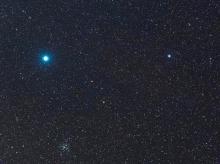Listen to today's episode of StarDate on the web the same day it airs in high-quality streaming audio without any extra ads or announcements. Choose a $8 one-month pass, or listen every day for a year for just $30.
You are here
Gomeisa
Our sedate, middle-aged Sun spins on its axis about once a month. This leisurely rate keeps the Sun nice and round, like a beachball. But some stars rotate much faster. In fact, some spin so fast that they flatten themselves out, like a squashed beachball.
An example is Gomeisa, the second-brightest star of Canis Minor, the little dog. It’s quite low in the east by about 9 o’clock. It’s above Procyon, the constellation’s brightest star.
Gomeisa is several times as massive as the Sun, and several times wider. And it spins much faster than the Sun does — about once per day. Since a star is made of gas, that high-speed rotation forces material outward at Gomeisa’s equator, giving the star its compressed appearance.
The rotation has another important effect. Gas at the equator is moving at more than half a million miles per hour. And since the equator is bulging outward, it “feels” less of a gravitational grip than material at the poles. So some of the hydrogen gas at the equator gets flung out into space, like water whirling away from a spinning lawn sprinkler. That surrounds Gomeisa with a disk of gas that’s several times wider than the star.
If you could get close to Gomeisa, you’d see one other odd effect. Because the gas at the poles is closer to the center of the star, it’s much hotter than gas at the equator. So the star’s poles are brighter than its equator — a two-toned appearance for a flattened star.
Script by Damond Benningfield




